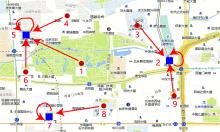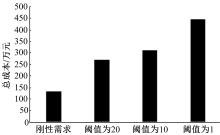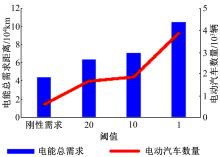吉林大学学报(工学版) ›› 2019, Vol. 49 ›› Issue (5): 1471-1477.doi: 10.13229/j.cnki.jdxbgxb20181270
• • 上一篇
考虑通勤需求的电动汽车充电站选址与定容模型
- 吉林大学 交通学院,长春 130022
Location and capacity model of electric vehicle charging station considering commuting demand
Qing-yu LUO( ),Wan-li TIAN,Hong-fei JIA(
),Wan-li TIAN,Hong-fei JIA( )
)
- College of Transportation, Jilin University, Changchun 130022, China
摘要:
为满足电动汽车通勤用户在工作地点附近的充电需求,构建了以充电站建设成本和用户广义充电成本最小为目标的充电站选址和定容模型。引入了便捷系数量化用户的充电期望以得到充电站需要服务的电动汽车数量和电能需求。计算实例表明:充电站选址对便捷系数阈值不敏感,但建设经济性随便捷系数阈值的减小而变差,由此提出了不同规划目标下便捷系数阈值取值范围的建议。
中图分类号:
- U491
| 1 | DongJ, LinZ. Within-day recharge of plug-in hybrid electric vehicles: energy impact of public charging infrastructure[J]. Transportation Research Part D: Transport and Environment, 2012, 17(5): 405-412. |
| 2 | NieY, GhamamiM, ZockaieA, et al. Optimization of incentive polices for plug-in electric vehicles[J]. Transportation Research Part B: Methodological, 2016, 84: 103-123. |
| 3 | NieY, GhamamiM. A corridor-centric approach to planning electric vehicle charging infrastructure[J]. Transportation Research Part B: Methodological, 2013, 57: 172-190. |
| 4 | HeF, YinY, ZhouJ. Deploying public charging stations for electric vehicles on urban road networks[J]. Transportation Research Part C: Emerging Technologies, 2015, 60: 227-240. |
| 5 | 程宏波, 肖永乐, 王勋, 等. 基于引力模型的电动汽车充电站选址规划[J]. 电工电能新技术, 2016, 35(5): 61-66. |
| ChengHong-bo, XiaoYong-le, WangXun, et al. Site planning of electric vehicles charging station based on gravity model[J]. Advanced Technology of Electrical Engineering & Energy, 2016, 35(5): 61-66. | |
| 6 | HuangY, ZhouY. An optimization framework for workplace charging strategies[J]. Transportation Research Part C: Emerging Technologies, 2015, 52: 144-155. |
| 7 | ZhuZ H, GaoZ Y, ZhengJ F, et al. Charging station location problem of plug-in electric vehicles[J]. Journal of Transport Geography, 2016, 52: 11-22. |
| 8 | YangY, YaoE, YangZ, et al. Modeling the charging and route choice behavior of BEV drivers[J]. Transportation Research Part C: Emerging Technologies, 2016, 65: 190-204. |
| 9 | SunX, YamamotoT, MorikawaT. Charge timing choice behavior of battery electric vehicle users[J]. Transportation Research Part D: Transport and Environment, 2015, 37: 97-107. |
| 10 | DongJ, LiuC, LinZ. Charging infrastructure planning for promoting battery electric vehicles: an activity-based approach using multiday travel data[J]. Transportation Research Part C: Emerging Technologies, 2014, 38: 44-55. |
| 11 | PearreN S, KemptonW, GuenslerR L, et al. Electric vehicles: how much range is required for a day’s driving[J]. Transportation Research Part C: Emerging Technologies, 2011, 19(6): 1171-1184. |
| [1] | 曹骞, 李君, 刘宇, 曲大为. 基于马尔科夫链的长春市乘用车行驶工况构建[J]. 吉林大学学报(工学版), 2018, 48(5): 1366-1373. |
| [2] | 孙宝凤, 高坤, 申琇秀, 梁婷. 基于能力平衡和变覆盖半径的加油站网络扩充选址模型[J]. 吉林大学学报(工学版), 2018, 48(3): 704-711. |
| [3] | 徐亮,程国柱. 基于车速离散度和经济车速的高速公路最低车速限制[J]. 吉林大学学报(工学版), 2010, 40(03): 661-0665. |
|
||







